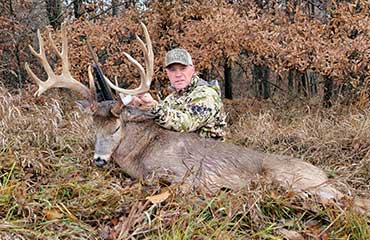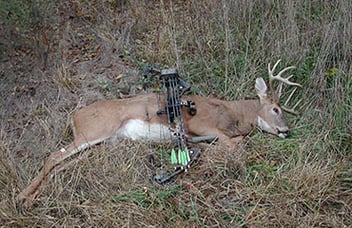We all want to get big bucks, but bigger isn’t always better, at least when you’re talking about optics.
Just like you match your clothing to the environment where you’re hunting, you also should match your optics choices to the style and terrain you most often hunt.
For the longest time, I didn’t even carry binoculars while bowhunting. My logic was that I can only shoot 35 yards, so why would I need binoculars? I’ve since realized the error of my thinking, and I now value the ability to see and identify distant deer to help make new plans and move stand locations.
That said, most often I can’t see more than 200 yards or so, even when hunting a field edge. Giant, heavy binoculars designed to glass mile-distant bucks in the West aren’t necessary for me and only serve to add weight and bulk. Conversely, I have been on two mule deer hunts where giant binoculars would have been a huge help. Other hunters could see individual tines on distant mulies, while I, with my under-powered binoculars, could only identify whether or not it was a buck.
Whether going on an occasional hunt like that justifies spending hundreds or even thousands of dollars on a new pair of binoculars can only be determined by your disposable income, but a good pair of 10x42s is adequate for almost any hunting situation.
The same size logic applies to scope choice. Long-distance shooting is popular right now, but recreational distance shooting is not hunting. Far too many hunters put huge scopes on their guns thinking bigger is better.
Bigger scopes don’t offer many advantages over the tried-and-true 3x9x40 scopes that dominated the market when I was cutting my hunting teeth. They also come with some significant disadvantages like bulk and extra weight.
Have you ever pulled up your gun and tried to focus on a close whitetail only to discover you had left your scope on 9x power? Good luck with that if the deer isn’t calm and standing perfectly still. That only gets worse with higher-power scopes.
Complicated reticles are another trend deer hunters could do without. You might use all those extra marks for target shooting, but I’ll take a simple, single crosshair or an uncomplicated BDC reticle every time.
In short, a 3-9x40 scope is more than adequate for 99% of whitetail hunts with centerfire rifles; and 2-7x32s, or something in that range, are great for shotguns, muzzleloaders and straight-wall guns. Keep your setups simple and sized to the type of hunting you do most.
Just like you match your clothing to the environment where you’re hunting, you also should match your optics choices to the style and terrain you most often hunt.
For the longest time, I didn’t even carry binoculars while bowhunting. My logic was that I can only shoot 35 yards, so why would I need binoculars? I’ve since realized the error of my thinking, and I now value the ability to see and identify distant deer to help make new plans and move stand locations.
That said, most often I can’t see more than 200 yards or so, even when hunting a field edge. Giant, heavy binoculars designed to glass mile-distant bucks in the West aren’t necessary for me and only serve to add weight and bulk. Conversely, I have been on two mule deer hunts where giant binoculars would have been a huge help. Other hunters could see individual tines on distant mulies, while I, with my under-powered binoculars, could only identify whether or not it was a buck.
Whether going on an occasional hunt like that justifies spending hundreds or even thousands of dollars on a new pair of binoculars can only be determined by your disposable income, but a good pair of 10x42s is adequate for almost any hunting situation.
The same size logic applies to scope choice. Long-distance shooting is popular right now, but recreational distance shooting is not hunting. Far too many hunters put huge scopes on their guns thinking bigger is better.
Bigger scopes don’t offer many advantages over the tried-and-true 3x9x40 scopes that dominated the market when I was cutting my hunting teeth. They also come with some significant disadvantages like bulk and extra weight.
Have you ever pulled up your gun and tried to focus on a close whitetail only to discover you had left your scope on 9x power? Good luck with that if the deer isn’t calm and standing perfectly still. That only gets worse with higher-power scopes.
Complicated reticles are another trend deer hunters could do without. You might use all those extra marks for target shooting, but I’ll take a simple, single crosshair or an uncomplicated BDC reticle every time.
In short, a 3-9x40 scope is more than adequate for 99% of whitetail hunts with centerfire rifles; and 2-7x32s, or something in that range, are great for shotguns, muzzleloaders and straight-wall guns. Keep your setups simple and sized to the type of hunting you do most.




.png)